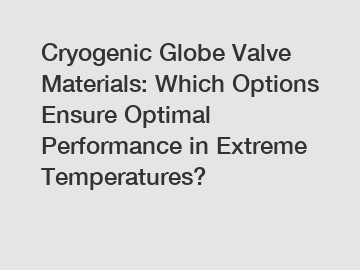Cryogenic Globe Valve Materials: Which Options Ensure Optimal Performance in Extreme Temperatures?
Cryogenic Globe Valve Materials: Which Options Ensure Optimal Performance in Extreme Temperatures?
The successful operation of cryogenic systems heavily relies on the use of high-quality materials that can withstand extreme temperatures. Cryogenic globe valves play a critical role in these systems, controlling the flow of gases and liquids at extremely low temperatures. But with so many materials available, which options ensure optimal performance in these harsh conditions? In this article, we will explore different materials commonly used in cryogenic globe valves and discuss their advantages and disadvantages.
1. Stainless Steel:

Stainless steel is one of the most popular materials used in cryogenic applications due to its excellent corrosion resistance and mechanical properties. However, it is important to select the appropriate grade of stainless steel to ensure optimal performance in extreme temperatures. Austenitic stainless steel such as 304 and 316L are commonly used due to their low-temperature toughness and resistance to brittleness. These materials can withstand temperatures as low as -196°C (-320°F) without losing their structural integrity.
2. Carbon Steel:
Carbon steel is another material often employed in cryogenic globe valves due to its strength and cost-effectiveness. It performs well at cryogenic temperatures and can handle extreme cold conditions better than many other materials. However, carbon steel is susceptible to corrosion, especially in the presence of moisture or certain gases. To mitigate this concern, carbon steel valves can be coated or lined to enhance their corrosion resistance.
3. Brass:
Brass is a common choice for cryogenic globe valves due to its good thermal conductivity and low-temperature strength. It is also resistant to freezing and offers good machinability. However, brass may not be suitable for extremely low-temperature applications, as it has a higher coefficient of thermal expansion than other materials. This can result in dimensional changes and leaks when subjected to rapid temperature fluctuations. Consequently, brass globe valves are typically recommended for cryogenic systems with less extreme temperature requirements.
4. Nickel Alloys:
Nickel alloys are known for their exceptional resistance to both high and low temperatures, making them ideal for cryogenic applications. In particular, alloys like Inconel and Monel are widely used in cryogenic globe valves. These materials exhibit excellent mechanical strength, corrosion resistance, and low-temperature ductility. Nickel alloys can maintain their performance even at temperatures as low as -269°C (-452°F), ensuring reliable operation in the most demanding cryogenic environments.
In conclusion, choosing the right material for cryogenic globe valves is vital to ensure optimal performance in extreme temperatures. Stainless steel, specifically austenitic grades like 304 and 316L, offer excellent corrosion resistance and low-temperature toughness. Carbon steel is cost-effective and performs well at cryogenic temperatures but requires additional corrosion protection. Brass is suitable for less extreme cryogenic applications, providing good thermal conductivity and resistance to freezing. Nickel alloys, such as Inconel and Monel, exhibit exceptional mechanical strength and corrosion resistance, making them ideal for the most demanding cryogenic environments.
When selecting the material for cryogenic globe valves, the specific requirements of the application, including temperature range, chemical compatibility, and mechanical stress, must be considered. Consulting with experienced valve manufacturers and suppliers can ensure the right material choice for optimal performance and longevity in extreme temperature conditions. So, in the realm of cryogenic globe valve materials, which options ensure optimal performance in extreme temperatures? The answer lies in understanding the unique demands of your cryogenic system and making an informed decision based on the advantages and limitations of each material.
Want more information on Thread Y Type Strainer, ANSI Bellows Seal Globe Valve, Forged Steel Bellow Seal Gate Valve? Feel free to contact us.
120
0
0


Comments
All Comments (0)